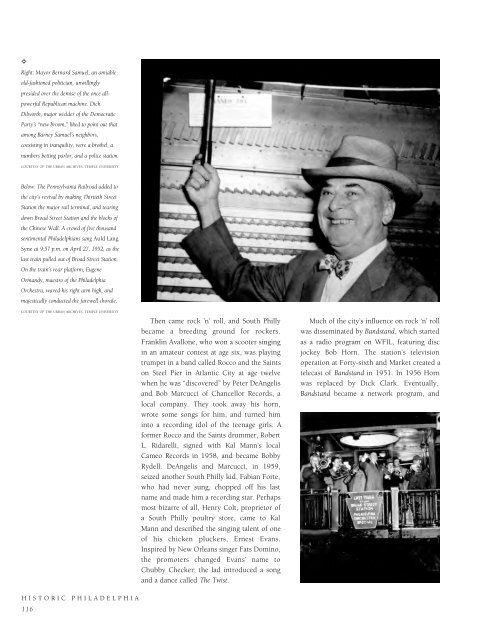Historic Philadelphia
An illustrated history of the city of Philadelphia, paired with the histories of companies, families and organizations that make the region great.
An illustrated history of the city of Philadelphia, paired with the histories of companies, families and organizations that make the region great.
Create successful ePaper yourself
Turn your PDF publications into a flip-book with our unique Google optimized e-Paper software.
✧<br />
Right: Mayor Bernard Samuel, an amiable<br />
old-fashioned politician, unwillingly<br />
presided over the demise of the once allpowerful<br />
Republican machine. Dick<br />
Dilworth, major wielder of the Democratic<br />
Party’s “new broom,” liked to point out that<br />
among Barney Samuel’s neighbors,<br />
coexisting in tranquility, were a brothel, a<br />
numbers betting parlor, and a police station.<br />
COURTESY OF THE URBAN ARCHIVES, TEMPLE UNIVERSITY.<br />
Below: The Pennsylvania Railroad added to<br />
the city’s revival by making Thirtieth Street<br />
Station the major rail terminal, and tearing<br />
down Broad Street Station and the blocks of<br />
the Chinese Wall. A crowd of five thousand<br />
sentimental <strong>Philadelphia</strong>ns sang Auld Lang<br />
Syne at 9:57 p.m. on April 27, 1952, as the<br />
last train pulled out of Broad Street Station.<br />
On the train’s rear platform, Eugene<br />
Ormandy, maestro of the <strong>Philadelphia</strong><br />
Orchestra, waved his right arm high, and<br />
majestically conducted the farewell chorale.<br />
COURTESY OF THE URBAN ARCHIVES, TEMPLE UNIVERSITY.<br />
Then came rock ’n’ roll, and South Philly<br />
became a breeding ground for rockers.<br />
Franklin Avallone, who won a scooter singing<br />
in an amateur contest at age six, was playing<br />
trumpet in a band called Rocco and the Saints<br />
on Steel Pier in Atlantic City at age twelve<br />
when he was “discovered” by Peter DeAngelis<br />
and Bob Marcucci of Chancellor Records, a<br />
local company. They took away his horn,<br />
wrote some songs for him, and turned him<br />
into a recording idol of the teenage girls. A<br />
former Rocco and the Saints drummer, Robert<br />
L. Ridarelli, signed with Kal Mann’s local<br />
Cameo Records in 1958, and became Bobby<br />
Rydell. DeAngelis and Marcucci, in 1959,<br />
seized another South Philly kid, Fabian Forte,<br />
who had never sung, chopped off his last<br />
name and made him a recording star. Perhaps<br />
most bizarre of all, Henry Colt, proprietor of<br />
a South Philly poultry store, came to Kal<br />
Mann and described the singing talent of one<br />
of his chicken pluckers, Ernest Evans.<br />
Inspired by New Orleans singer Fats Domino,<br />
the promoters changed Evans’ name to<br />
Chubby Checker; the lad introduced a song<br />
and a dance called The Twist.<br />
Much of the city’s influence on rock ‘n’ roll<br />
was disseminated by Bandstand, which started<br />
as a radio program on WFIL, featuring disc<br />
jockey Bob Horn. The station’s television<br />
operation at Forty-sixth and Market created a<br />
telecast of Bandstand in 1951. In 1956 Horn<br />
was replaced by Dick Clark. Eventually,<br />
Bandstand became a network program, and<br />
HISTORIC PHILADELPHIA<br />
116
















